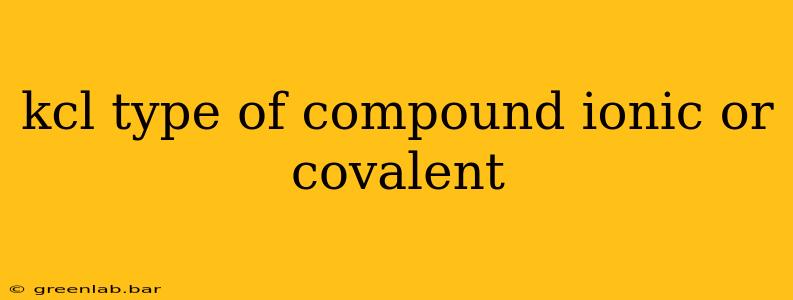Potassium chloride (KCl), a common chemical compound, is a quintessential example of an ionic compound. Understanding why requires a look at its constituent elements and the nature of chemical bonding. This article will explore the characteristics of KCl, explaining definitively why it's classified as ionic and not covalent.
Understanding Ionic vs. Covalent Bonds
Before delving into the specifics of KCl, let's clarify the fundamental difference between ionic and covalent bonds:
-
Ionic Bonds: These bonds form through the electrostatic attraction between oppositely charged ions. This happens when one atom donates an electron (or more) to another atom, creating a positively charged cation and a negatively charged anion. The resulting strong attraction holds the ions together. Ionic compounds generally have high melting and boiling points, are often soluble in water, and conduct electricity when dissolved or molten.
-
Covalent Bonds: In contrast, covalent bonds involve the sharing of electrons between atoms. This sharing creates a stable molecule where the atoms are held together by the shared electron pair. Covalent compounds generally have lower melting and boiling points than ionic compounds and are often not soluble in water. They typically do not conduct electricity.
The Case of Potassium Chloride (KCl)
Potassium (K) is an alkali metal in Group 1 of the periodic table. It has one electron in its outermost shell, which it readily loses to achieve a stable electron configuration (like the noble gas Argon). This loss of an electron transforms potassium into a positively charged ion, K⁺ (potassium cation).
Chlorine (Cl) is a halogen in Group 17. It has seven electrons in its outermost shell and readily gains one electron to achieve a stable electron configuration (also like Argon). This gain of an electron transforms chlorine into a negatively charged ion, Cl⁻ (chloride anion).
The strong electrostatic attraction between the positively charged K⁺ ion and the negatively charged Cl⁻ ion forms the ionic bond in KCl. This transfer of electrons, not the sharing, is the defining characteristic of the ionic bond in potassium chloride.
Properties Supporting the Ionic Nature of KCl
Several properties of KCl further confirm its ionic nature:
-
High Melting and Boiling Point: KCl has a relatively high melting point (770°C) and boiling point (1420°C), indicative of strong ionic bonds requiring significant energy to break.
-
Solubility in Water: KCl is readily soluble in water. Water molecules, being polar, can effectively surround and separate the K⁺ and Cl⁻ ions, allowing them to dissolve.
-
Electrical Conductivity: When dissolved in water or molten, KCl conducts electricity. This is because the freely moving ions (K⁺ and Cl⁻) can carry an electric current.
Conclusion: KCl is definitively an ionic compound.
The transfer of electrons from potassium to chlorine to form K⁺ and Cl⁻ ions, coupled with the characteristic properties of high melting point, water solubility, and electrical conductivity when dissolved or molten, unequivocally classifies potassium chloride (KCl) as an ionic compound, not a covalent one. The strong electrostatic attraction between the oppositely charged ions is the driving force behind its formation and properties.

